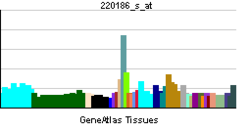- PCLKC
-
Cadherin-related family member 2 Identifiers Symbols CDHR2; FLJ20124; FLJ20383; MGC163154; PCDH24; PCLKC External IDs MGI: 2687323 HomoloGene: 9776 GeneCards: CDHR2 Gene Gene Ontology Molecular function • calcium ion binding
• protein bindingCellular component • plasma membrane
• integral to membrane
• apical plasma membrane
• cell junctionBiological process • cell adhesion
• homophilic cell adhesion
• negative regulation of cell growthSources: Amigo / QuickGO RNA expression pattern 
More reference expression data Orthologs Species Human Mouse Entrez 54825 268663 Ensembl ENSG00000074276 ENSMUSG00000034918 UniProt Q9BYE9 n/a RefSeq (mRNA) NM_001171976.1 NM_001033364.3 RefSeq (protein) NP_001165447.1 NP_001028536.2 Location (UCSC) Chr 5:
175.97 – 176.02 MbChr 13:
54.8 – 54.84 MbPubMed search [1] [2] Protocadherin-24 is a protein that in humans is encoded by the PCDH24 gene.[1][2][3]
This gene is a member of the protocadherin family, which represents a subset of the larger cadherin superfamily. The members of the protocadherin family encode non-classical cadherins that function as calcium-dependent cell-cell adhesion molecules. The kidney-expressed gene product has a signal peptide, nine cadherin repeat domains and a unique cytoplasmic region. This protocadherin represents a new candidate for tumor suppression.[3]
Interactions
PCLKC has been shown to interact with MAST2.[2]
References
- ^ Suzuki ST (Dec 2000). "Recent progress in protocadherin research". Exp Cell Res 261 (1): 13–8. doi:10.1006/excr.2000.5039. PMID 11082270.
- ^ a b Okazaki N, Takahashi N, Kojima S, Masuho Y, Koga H (Jul 2002). "Protocadherin LKC, a new candidate for a tumor suppressor of colon and liver cancers, its association with contact inhibition of cell proliferation". Carcinogenesis 23 (7): 1139–48. doi:10.1093/carcin/23.7.1139. PMID 12117771.
- ^ a b "Entrez Gene: PCLKC protocadherin LKC". http://www.ncbi.nlm.nih.gov/sites/entrez?Db=gene&Cmd=ShowDetailView&TermToSearch=54825.
Further reading
- Yang LY, Wang W, Peng JX, et al. (2005). "Differentially expressed genes between solitary large hepatocellular carcinoma and nodular hepatocellular carcinoma.". World J. Gastroenterol. 10 (24): 3569–73. PMID 15534908.
- Ota T, Suzuki Y, Nishikawa T, et al. (2004). "Complete sequencing and characterization of 21,243 full-length human cDNAs.". Nat. Genet. 36 (1): 40–5. doi:10.1038/ng1285. PMID 14702039.
- Strausberg RL, Feingold EA, Grouse LH, et al. (2003). "Generation and initial analysis of more than 15,000 full-length human and mouse cDNA sequences.". Proc. Natl. Acad. Sci. U.S.A. 99 (26): 16899–903. doi:10.1073/pnas.242603899. PMC 139241. PMID 12477932. http://www.pubmedcentral.nih.gov/articlerender.fcgi?tool=pmcentrez&artid=139241.
- Suzuki Y, Yoshitomo-Nakagawa K, Maruyama K, et al. (1997). "Construction and characterization of a full length-enriched and a 5'-end-enriched cDNA library.". Gene 200 (1–2): 149–56. doi:10.1016/S0378-1119(97)00411-3. PMID 9373149.
- Hillier LD, Lennon G, Becker M, et al. (1997). "Generation and analysis of 280,000 human expressed sequence tags". Genome Res. 6 (9): 807–28. doi:10.1101/gr.6.9.807. PMID 8889549.
- Maruyama K, Sugano S (1994). "Oligo-capping: a simple method to replace the cap structure of eukaryotic mRNAs with oligoribonucleotides". Gene 138 (1–2): 171–4. doi:10.1016/0378-1119(94)90802-8. PMID 8125298.
Categories:- Human proteins
- Chromosome 5 gene stubs
Wikimedia Foundation. 2010.
